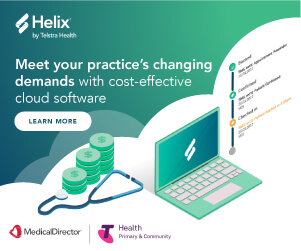5 Myths about health cloud software debunked
In this article, we take a look at five common myths in the healthcare industry around healthcare in the cloud, and set the record straight on its potential to revolutionise the healthcare industry.
Myth 1: GPs aren’t ready for the cloud
One of the misunderstandings in industry conversations is that GPs, especially those who are used to paper-based or on-premise clinical management solutions aren’t quite ready for the cloud, or hesitant to embrace change.
However, a new study by BCC Research has revealed cloud computing is now becoming more widely adopted. In fact, the report showed increased patient and practitioner expectations for healthcare technology to offer anytime/anywhere access is driving the adoption of cloud technology across the healthcare space, globally.
The report, Healthcare Cloud Computing: Global Markets to 2022, predicts the global market for healthcare cloud computing to grow at a compound annual growth rate of 11.6% from 2017 through 2022, to reach $35.0 billion by 2022. This exponential growth is linked to cloud-based solutions allowing faster access from anywhere, and any device, while offering better diagnostic quality and instant online access to patient images and reports.
Meanwhile last year, a survey conducted by KLAS Research found 70 per cent of healthcare organisations in the US have moved at least some applications or IT infrastructure off-premises and over half of those healthcare organisations have moved their electronic medical record (EMR) applications to a hosting or cloud environment. Among the surveyed healthcare provider organisations, cloud infrastructure providers were the most commonly considered.
In Australia, a white paper by MedicalDirector revealed the benefits of cloud-based health solutions, with, 64% of respondents admitting they consider flexibility to be the main benefit of using a cloud-based HER/PMS systems.
Myth 2: Cloud technology is too expensive
While healthcare IT systems are historically expensive to implement, update and maintain, the BCC Research further revealed how cloud economics is changing that by shifting from individual budgets to cost-sharing models enabled by private, multi-tenant, and in some cases, public clouds.
In fact, in 2017, cloud adoption in healthcare increased globally, as cost savings outweighed potential data protection concerns.
Myth 3: Switching to cloud is difficult
While hardware is vital to deliver cloud services, software is the key technology enabler, and will remain the largest market segment to drive true efficiency and enable better health outcomes, the BCC report found. This is because robust, cloud-based software offers significant benefits, allowing users to leverage the same resources in a more flexible way, and allows those applications to access a common data model (CDM), while also offering customised end-user interfaces.
At the same time, establishing, leading technology providers such as MedicalDirector provide premium support to all healthcare professionals ready to make the switch, so turning to the cloud is easy, seamless, with minimal interruption.
“Many in healthcare systems still rely on handwritten notes and paper charts,” BCC Research senior IT editor, Michael Sullivan, said. “Investing in cloud for healthcare providers represents a cultural change that will require time to realise, but even still, BCC Research expects a greater portion of total healthcare IT spending to migrate to cloud technologies.”
Myth 4: The cloud isn’t secure
Contrary to common perception, cloud-based platforms offer a more secure, robust, and reliable solution than server or on-premise solutions.
And with tougher cyber security laws now in full force, the pressure is on the healthcare industry to take security and compliance seriously.
Cloud-based applications like Helix, built on the robust market leading Microsoft Azure platform, are becoming far more secure and sophisticated than on-premises legacy solutions. This is because cloud service providers ensure data is encrypted, backed up, easily recoverable, and secured with strict role-based access. It is also prudent to note that while cloud solution providers implement their security measures, healthcare organisations must ensure they have the right security architecture in place to keep sensitive data safe.
And while all data storage solutions have vulnerabilities, the benefit of the cloud is that much of the maintenance that minimises data-loss risk is automated, for example with robust system back-ups. And only those you have given permission to can access the data you store in the cloud. So, in actuality, fewer people have access to data stored in the cloud than data stored on local servers.
Myth 5: Cloud technology isn’t scalable
To harvest best results, healthcare organisations need to utilise highly-integrated, cloud-based interoperable systems that enable not only effective data management and security, but also offer infinite scalability. Cloud computing architecture enables large data sets to be hosted, maintained, easily accessed and rapidly analysed, making big data queries easier to process in a timely and cost-effective manner.
And new technological advancements like MedicalDirector’s Helix platform have made it possible for health organisations to retire legacy data management tools in favour of more flexible, scalable solutions to meet their needs. Such reputable cloud providers also offer state-of-the-art security, and also comply with strict data protection standards.
By helping to remove the traditional shackles of infrastructure, healthcare organisations that embrace cloud can leverage data in a secure, scalable way, and achieve a more effective big data strategy that ultimately drives better patient outcomes.
Additional benefits of cloud in terms of enabling more effective interoperability in healthcare include:
- Offering a scalable and flexible solution that can lower operational burdens
- Cloud-based interoperability complements value-based, patient-centric care and population health efforts
- Cloud-based solutions can open an opportunity for a greater, more connected digital ecosystem while ensuring security is a priority
- Cloud-based interoperability can help reduce administrative burdens and benefit billing and reimbursement processes.
- Unifying clinical systems into a single, cloud-hosted application and improved functionality and clinical workflow
- Cloud-based systems allow the storage of big data, and enable data-driven decision-making, which helps the health industry deliver more accurate and timely health outcomes
Moving forward, misunderstanding the potential, impact and scale of cloud-based clinical management software can significantly inhibit the healthcare industry’s ability to leverage new technologies to enable better health outcomes.
And legacy patient data systems will simply not be able to keep up with the next generation of cloud-based systems that better-support and promote interoperability. At the same time, increased security, and more robust, cloud-based solutions are opening up fresh opportunities to embrace a more scalable and flexible solution that will help propel the scope of interoperable digital healthcare into the future.









